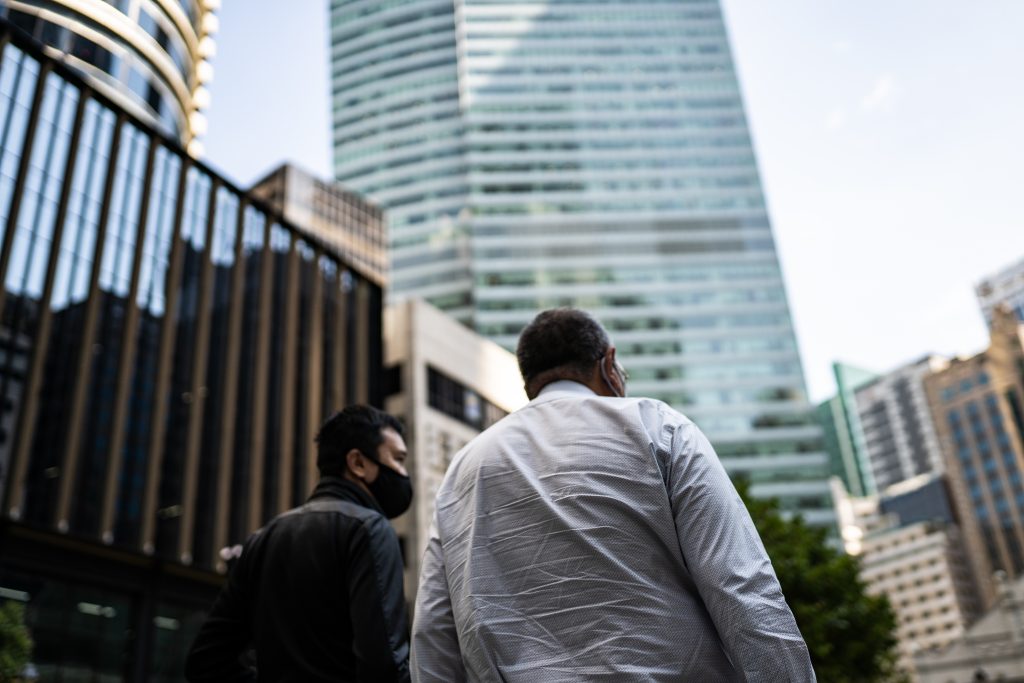Top images: Tey Liang Jin/Rice File Photo
*Frida is a Quiet Quitter. She’s been a Quiet Quitter for two years now. She is not alone.
“My life turned upside down when I got sick. I was fighting for my life for a year,” the secondary school teacher shares. When Frida fell sick, her colleagues and middle managers were more concerned about the extra work they had to do than her health.
“It’s one thing not being appreciated. But it was another realising that was taken for granted.”
“No one is indispensable in the civil service.”
It’s three on a Thursday afternoon when I first speak to Frida, a language teacher in her late 30s with over ten years of teaching experience. She takes the interview with me in an empty classroom in her school. The walls behind her, in a run-down shade of off-white, give her location away.
Mid-conversation, a colleague interrupts. Just a Zoom session, she plays it off casually.
A few years ago, Frida was struck with a debilitating illness that left her hospitalised for six weeks. Eight months after being hospitalised, she returned to work—albeit with restricted mobility. She was also given a workload that doesn’t involve anything beyond classroom teaching.
Although she has since regained her physical strength, her recovery is still an ongoing process, she tells me.
She had already attended a full day of lessons and meetings before our interview. At that point, she had spent nine hours in school and had more work left to do.
“I’m going to mark papers until five after this,” she reveals. Before illness struck, she would’ve worked until seven in the evening.
“I was a workaholic. I gave it my all—110 percent. People told me that they didn’t know whether to emulate or pity me,” she recounts.
Quiet Quitting, Defined
I was struck by Frida’s willingness to speak to me. After all, Quiet Quitting was about staying under the radar. Frida decided to talk to me on the condition of anonymity because she felt it was important for people to know that Quiet Quitting is not just a mere phase.
Quiet Quitting is a workplace trend that first gained currency on Tiktok. The movement was introduced to the site when a user, @zkchillin, shared his first impressions of Quiet Quitting—a term he had recently learnt.
With a calm tone juxtaposed against a melodic dream-like piano sequence in the background, @zkchillin narrates: “You’re not quitting your job. But you’re quitting the idea of going above and beyond. You no longer subscribe to the hustle culture mentality.”
The video, barely 17 seconds long, is an almost therapeutic watch. It has since amassed over 3.3 million views, no doubt shared widely by other individuals going through the same.
As the most overworked country in the Asia Pacific region, it’s no surprise, then, that Quiet Quitting resonates with employees based in Singapore.
At first blush, Quiet Quitting seems like a typical Gen Z-esque idea—yet another innovation to dilute strong work ethics and escape hard work. However, Quiet Quitting is anything but. It’s misunderstood.
What’s Quiet Quitting, really?
The movement has an uncanny ability to provide a sense of solidarity to overworked employees everywhere. Misery does love company.
Still, beyond its ability to unite workers, the practice looks surprisingly different for different people. This is important to understand and bears repeating—one of the trend’s biggest misinterpretations is in trying to paint everyone with the same Quiet Quitting brush.
29-year-old Sharine* readily admits to Quiet Quitting her previous job as a marketing executive in the healthcare industry. The extreme micromanagement she was subjected to by her direct supervisor pushed her to join the movement.
“I wanted to make an impact in the industry with my ideas. But I realised my superiors didn’t value my ideas, and I couldn’t make a difference.”
For her, Quiet Quitting presents itself as a state of limbo, the mid-point between not wanting to be at your current job and searching for another role to jump on to. She does the bare minimum as a result.
“I wake up as late as possible and appear online only to answer emails sent to me. I do the work I’m asked to do, but I don’t initiate or propose new ideas.”
Frida views her version of Quiet Quitting slightly differently. For her, it means doing the job she was assigned but with more explicit boundaries.
“I am a responsible educator. I will mark and teach well. But I will not do anything more. If I can leave at five, then I am going to leave at five,” she asserts.

Taking On the Cynics
Quiet Quitting varies for different people because of their circumstances. After all, differentiating where work stops and life begins is a matter of individual taste, preference, and values. It’s an exercise that begs deep reflection and fine-tuning.
While this ambiguity is great for Quiet Quitters—who get to decide for themselves how best to take back their lives—it’s not so great for the broader movement.
Quiet Quitting’s enigma is fertile ground for critics. It’s nothing more than glorified laziness, cynical productivity proselytisers decry. They say that Quiet Quitting is a move that damages future career prospects and earning potential. After all, why Quiet Quit when true freedom from the workplace requires a strong financial base? To them, Quiet Quitting is merely a myopic misstep.
Through an employer’s lens, Quiet Quitting is tantamount to the cold shoulder treatment at the workplace. A detectable drop in enthusiasm is contagious. Once a fellow employee catches the scent of a Quiet Quitter, heads and morales drop—even when some employees never intended to Quiet Quit in the first place.
On top of that, Quiet Quitting can potentially be misused by employees who want to slack off, simply because they can. When probed further, there are no deeper underlying reasons for their Quiet Quitting.
But at its core, Quiet Quitting is about empowering the worker. Amidst the zeitgeist of hustle culture, one that normalises filling up most of our precious time with work, Quiet Quitting wants to normalise healthy boundaries.
And despite the labels naysayers throw at them, all Quiet Quitters want is to escape the clutches of today’s hustle culture and find an out from the unending rat race. Perhaps this antithesis to deeply-held beliefs of what a model worker should look like (read: tired, overworked, unhappy) is what Quiet Quitting detractors find hard to comprehend.

The Latest Internet Work Trend
By any stretch of the imagination, Quiet Quitters are not asking for the moon when they choose to opt out of an anxiety-inducing existence. All they yearn for is positive workplace culture and time for them to create a meaningful life outside of work.
This fundamental goal sounds surprisingly far-fetched, especially in a post-pandemic world where working from home blurs the line between working hours and rest. Now that we’re all returning to the office, some of us have forgotten to leave behind such unsustainable work attitudes.
And as long as Quiet Quitting persists, it will continue to make a mockery of all the nascent discourse surrounding work-life balance.

According to 29-year-old Ellie*, who Quiet Quit her previous job as a social worker, the movement reminds her that over-blurred boundaries between work and play do no good.
“I needed some form of separation when I was working with different people. I remember I was counselling someone who was in an unhealthy relationship,” Ellie recalls.
“It drained me emotionally. It was hard to stop thinking about it.”
Perhaps, the combination of Quiet Quitting’s existence and its reactions form the smoking gun we never knew we needed—that the concept of a work-life balance and a positive workplace culture needs to be relooked at and reworked.
Still, at its roots, Quiet Quitting is an internet trend. And like all internet trends, it’s difficult to predict how long the momentum will last.
One can only hope that when Quiet Quitting inevitably burns out, its dying rays will illuminate the path toward better workplaces for all. And that the effortful non-efforts of the Quiet Quitter would not have been in vain.

We Should All Quiet Quit. For Now, at Least.
Beyond disillusioned employees looking to jump ship, Quiet Quitting offers an alternative lens through which we can view our relationship with work—that we are more than the work we do if we allow ourselves to be.
The emotional distance that Quiet Quitting affords us can put work into perspective. At the very least, we can discover whether work-related activities are something we’d genuinely feel is the best use of our time.
TLDR: There’s nothing wrong with choosing to be occupied with work, as long as we truly want to.
Ellie, the former social worker, concurs. The distance that Quiet Quitting gave her made her realise that it was not the industry that was the root of her problems—it was the job she had taken that afforded little separation between work and life.
“After Quiet Quitting and some time away, I realised that I actually like social work. Meeting different people and helping them is something I want to do. Right now, I’m considering pursuing graduate studies in social work.”
Indeed, Ellie is now better prepared to deal with the inevitable drain that comes with the unseen emotional labour of social work—all thanks to Quiet Quitting.

Finding the Right Quiet Quitting
Half an hour into our conversation, Frida has said all that could be said about Quiet Quitting. For an experienced Quiet Quitter such as herself, she is clear about her version of the movement. In fact, she could be considered a pioneer Quiet Quitter; she was doing it before it even had a name.
“I got into baking when everyone was making sourdough bread at home,” Frida shares about the time she has for herself now, her eyes lighting up. It’s a stark change in mood from our previous topic of discussion.
“I bake fortnightly now and donate some of my bakes to community service groups working with the underprivileged.”
Frida offers potential Quiet Quitters advice about the process of fine-tuning and creating a Quiet Quitting philosophy that’s right for you.
“Be honest with yourself. It’s okay when things don’t work out, and you need a change in direction.”
“Ask yourself what makes you happy. Don’t be afraid to explore that.”
Frida shifts in her seat, ready to make a move to the staff room. An hour of marking awaits. Then, she gets to go home to her daughter and her family. It’s her source of comfort and happiness—along with baking, of course.
“During my time off, I’ve had time to reflect on what is meaningful to me. I appreciate the little things now. Taking warm showers. Reading with my daughter—she has an extensive vocabulary for her age.”
And despite all that talk about Quiet Quitting, Frida is still committed to her job.
“I get satisfaction from teaching. I enjoy teaching. But I realised I could not expect the job to give me all the satisfaction. I have to take charge of my own happiness,” concludes Frida. For now, Quiet Quitting will have to do.
*Name has been changed to protect their identity






